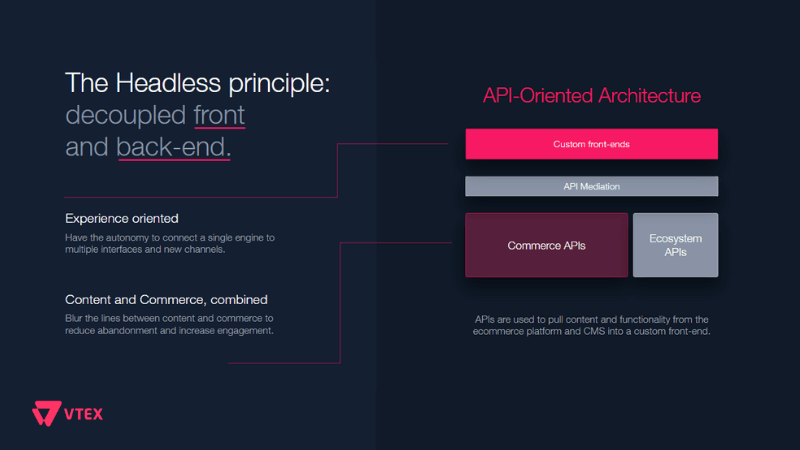Headless commerce is a commercial architecture that allows the separation of the front-end and the back-end. A headless architecture allows more flexibility, complexity, and agility for businesses. Headless commerce is about a different way of coordinating development activity. This separation gives businesses the freedom to build whatever they want. This offers a new unique customer experience.
Is the headless approach right for everyone?

Benefits of headless commerce:
- Flexibility: The platform with a predefined front-end is eliminated, which means that headless commerce allows developers to create a user experience from scratch, which fits perfectly with business needs. They do not have to worry about modifying backend databases, which significantly reduces the possibility of errors;
- High degree of customization and adaptability: Because developers can create the platform from scratch, there is greater control over the appearance and experience of users;
- Microservices architecture: Microservices are increasingly used, as developers work to create larger, more complex applications that are better developed and managed as a combination of smaller services that work together for more extensive, application-wide functionality. Some of the advantages offered by the microservices architecture: easy to implement and understand, faster isolation of defects, smaller and faster developer, scalability;
- Easy integrations: a headless commerce solution using APIs, which facilitates integration with other software;
- Fast implementation;
- Speed and agility;
- Increased performance;
- Advanced security;
- The possibility to remain competitive on the market;
- True omnichannel;
- Short time-to-market.
Headless commerce compared to traditional commerce
Headless commerce decouples the back-end functionality from the front-end functionality of the online store. Thus, online stores manage and deliver content through API calls without a connected front-end layer. This offers more flexibility to create a unique and user-friendly experience for site visitors. In the case of traditional commerce, any change in the back-end must be made in the front-end. This action is necessary because the commercial functionality is connected to the front-end framework, such as the website.
Therefore, headless commerce offers more flexibility because the content is not related to the other components of the website. It can offer customers an extreme customization experience, which is not limited by the front-end template. However, a higher level of technical knowledge is required to be implemented effectively.
By decoupling front-end and back-end experiences, VTEX gives business leaders the flexibility and autonomy to build experiences that are perfectly aligned with customer expectations and needs. This led to the development of VTEX IO.
VTEX IO is a low-code cloud-native development platform that helps deliver fast business solutions.
What are the benefits of using VTEX IO?
- Separating front-end from the back-end, and creating experiences for any customer contact point – web, mobile, voice, chatbot, IoT, AR / VR, or any other emerging contact point.
- Delivering an amazing experience faster. By reducing the complexity of the development process, VTEX IO allows teams to focus on building the best commercial solutions at a much higher speed.
- Customized solutions. The VTEX IO architecture allows developers to create customized solutions without other constraints. You can customize the front end, you can create applications or integrations for the back end.
- All information in one place: data related to inventory, logistics, and fulfillment are managed from a single platform.
- It is possible to connect external sources, extend back-end applications and synchronize with VTEX APIs to unlock every business opportunity determined by customer data.

Digitization has been adopted both at the organizational level and at the industry level.
Have you ever wondered what makes an e-commerce website successful? One of the main ingredients is the overall good customer experience. We have selected 5 actions that you should do to improve e-commerce customer experience.
